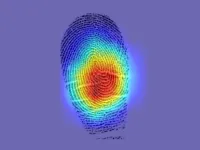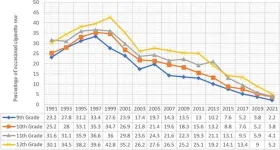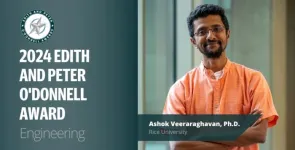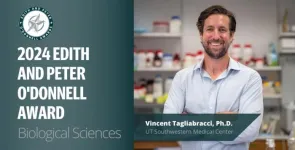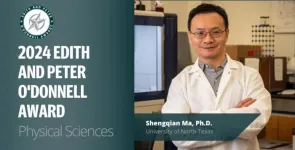(Press-News.org) Columbia engineers have built a new AI that shatters a long-held belief in forensics–that fingerprints from different fingers of the same person are unique. It turns out they are similar, only we’ve been comparing fingerprints the wrong way!
New York, NY—January 12, 2024—From “Law and Order” to “CSI,” not to mention real life, investigators have used fingerprints as the gold standard for linking criminals to a crime. But if a perpetrator leaves prints from different fingers in two different crime scenes, these scenes are very difficult to link, and the trace can go cold.
It’s a well-accepted fact in the forensics community that fingerprints of different fingers of the same person--”intra-person fingerprints”--are unique, and therefore unmatchable.
Research led by Columbia Engineering undergraduate
A team led by Columbia Engineering undergraduate senior Gabe Guo challenged this widely held presumption. Guo, who had no prior knowledge of forensics, found a public U.S. government database of some 60,000 fingerprints and fed them in pairs into an artificial intelligence-based system known as a deep contrastive network. Sometimes the pairs belonged to the same person (but different fingers), and sometimes they belonged to different people.
AI has potential to greatly improve forensic accuracy
Over time, the AI system, which the team designed by modifying a state-of-the-art framework, got better at telling when seemingly unique fingerprints belonged to the same person and when they didn’t. The accuracy for a single pair reached 77%. When multiple pairs were presented, the accuracy shot significantly higher, potentially increasing current forensic efficiency by more than tenfold. The project, a collaboration between Hod Lipson’s Creative Machines lab at Columbia Engineering and Wenyao Xu’s Embedded Sensors and Computing lab at University at Buffalo, SUNY, was published today in Science Advances.
Study findings challenge–and surprise–forensics community
Once the team verified their results, they quickly sent the findings to a well-established forensics journal, only to receive a rejection a few months later. The anonymous expert reviewer and editor concluded that “It is well known that every fingerprint is unique,” and therefore it would not be possible to detect similarities even if the fingerprints came from the same person.
The team did not give up. They doubled down on the lead, fed their AI system even more data, and the system kept improving. Aware of the forensics community's skepticism, the team opted to submit their manuscript to a more general audience. The paper was rejected again, but Lipson, who is the James and Sally Scapa Professor of Innovation in the Department of Mechanical Engineering and co-director of the Makerspace Facility, appealed. “I don’t normally argue editorial decisions, but this finding was too important to ignore,” he said. “If this information tips the balance, then I imagine that cold cases could be revived, and even that innocent people could be acquitted.”
While the system’s accuracy is not sufficient to officially decide a case, it can help prioritize leads in ambiguous situations. After more back and forth, the paper was finally accepted for publication by Science Advances.
Unveiled: a new kind of forensic marker to precisely capture fingerprints
One of the sticking points was the following question: What alternative information was the AI actually using that has evaded decades of forensic analysis? After careful visualizations of the AI system’s decision process, the team concluded that the AI was using a new kind of forensic marker.
“The AI was not using ‘minutiae,’ which are the branchings and endpoints in fingerprint ridges – the patterns used in traditional fingerprint comparison,” said Guo, who began the study as a first-year student at Columbia Engineering in 2021. “Instead, it was using something else, related to the angles and curvatures of the swirls and loops in the center of the fingerprint.”
Columbia Engineering senior Aniv Ray and PhD student Judah Goldfeder, who helped analyze the data, noted that their results are just the beginning. “Just imagine how well this will perform once it’s trained on millions, instead of thousands of fingerprints,” said Ray.
VIDEO: https://youtu.be/s5esfRbBc18
A need for broader datasets
The team is aware of potential biases in the data. The authors present evidence that indicates that the AI performs similarly across genders and races, where samples were available. However, they note, more careful validation needs to be done using datasets with broader coverage if this technique is to be used in practice.
Transformative potential of AI in a well-established field
This discovery is an example of more surprising things to come from AI, notes Lipson, . “Many people think that AI cannot really make new discoveries–that it just regurgitates knowledge,” he said. “But this research is an example of how even a fairly simple AI, given a fairly plain dataset that the research community has had lying around for years, can provide insights that have eluded experts for decades.”
He added, “Even more exciting is the fact that an undergraduate student, with no background in forensics whatsoever, can use AI to successfully challenge a widely held belief of an entire field. We are about to experience an explosion of AI-led scientific discovery by non-experts, and the expert community, including academia, needs to get ready.”
###
About the Study
The paper is titled “Unveiling Intra-Person Fingerprint Similarity via Deep Contrastive Learning.”
Authors are: Gabe Guo, Aniv Ray, Judah Goldfeder, and Hod Lipson, Columbia Engineering; Miles Izydorczak, Tufts University; and Wenyao Xu, University at Buffalo, SUNY.
The work is part of a joint University of Washington, Columbia and Harvard NSF AI Institute for Dynamical Systems, aimed to accelerate scientific discovery using AI.
The study was supported by NSF AI Institute for Dynamical Systems 2112085, and NSF REU Site 2050910.
The authors declare no financial or other conflicts of interest.
Media contact:
Holly Evarts, Director of Strategic Communications and Media Relations
347-453-7408 (c) | 212-854-3206 (o) | holly.evarts@columbia.edu
###
LINKS:
Paper: https://www.science.org/doi/10.1126/sciadv.adi0329
DOI: 10.1126/sciadv.adi0329
VIDEO: https://youtu.be/s5esfRbBc18
PROJECT WEBSITE: https://creativemachineslab.com/fingerprints.html
###
END
AI discovers that not every fingerprint is unique
Columbia engineers have built a new AI that shatters a long-held belief in forensics–that fingerprints from different fingers of the same person are unique. It turns out they are similar, only we’ve been comparing fingerprints the wrong way!
2024-01-10
ELSE PRESS RELEASES FROM THIS DATE:
JMIR Mental Health accepted for MEDLINE indexing
2024-01-10
JMIR Publications is pleased to announce that JMIR Mental Health (JMH) has been accepted for inclusion in MEDLINE, which is the U.S. National Library of Medicine's premier bibliographic database.
JMIR Mental Health had already been indexed in PubMed previously. MEDLINE is a more selective subset of PubMed, consisting of the top 5,200 biomedical journals. Indexing in MEDLINE also means that articles are now also indexed with NLM Medical Subject Headings (MeSH terms) and other metadata.
Selection for MEDLINE is a result of a thorough review of the ...
Reduced drug use is a meaningful treatment outcome for people with stimulant use disorders
2024-01-10
Reducing stimulant use was associated with significant improvement in measures of health and recovery among people with stimulant use disorder, even if they did not achieve total abstinence. This finding is according to an analysis of data from 13 randomized clinical trials of treatments for stimulant use disorders involving methamphetamine and cocaine. Historically, total abstinence has been the standard goal of treatment for substance use disorders, however, these findings support the growing recognition that a more nuanced perspective on measuring treatment success may be beneficial.
The study, published in Addiction, was led by scientists at the Johns Hopkins Bloomberg School of Public ...
Blood test distinguishes neuroendocrine subtype of advanced prostate cancer
2024-01-10
Boston – Like a criminal entering a witness protection program, cancer cells can shed their past and take on a new identity. Detecting such an identity-switch is particularly challenging when metastatic castration-resistant prostate cancer (CRPC) advances from adenocarcinoma to neuroendocrine prostate cancer (NEPC), a very difficult cancer to treat.
Now, however, researchers at Dana-Farber Cancer Institute and the University of Trento, Italy, have developed a blood test, described in Cancer Discovery, that can ...
Dramatic decline in cigarette use among U.S. teens over three decades
2024-01-10
Cigarette smoking remains the leading avoidable cause of premature death in the United States, accounting for approximately 500,000 deaths or 1 in 5 deaths annually. According to the U.S. Department of Health and Human Services, most adults who smoke cigarettes started before age 18, so preventing cigarette smoking in adolescents is important to reducing smoking in adults.
In a new study, researchers from Florida Atlantic University’s Schmidt College of Medicine and collaborators explored overall trends in cigarette smoking among a large sample of U.S. adolescents in grades nine to 12 from 1991 to 2021. They ...
Finding a home for the wandering mushrooms —— Phylogenetic and taxonomic updates of Agaricales
2024-01-10
Many edible, medicinal, and poisonous mushrooms that we are familiar with belong to the order Agaricales, which is a group of fungi with important economic and ecological value. Understanding the phylogenetic relationships of Agaricales can help us to know their evolutionary history and diversity, as well as their interactions with other organisms. Moreover, the phylogenetic framework of Agaricales can provide a basis for conserving biodiversity, such as measuring phylogenetic diversity and assessing the uniqueness and importance of different species.
Previous studies divided Agaricales into 8 suborders and 46 families, but the systematic position and phylogenetic relationship ...
ALS: blocking inflammation to reduce symptoms
2024-01-10
Québec, January 10, 2024 – In people with amyotrophic lateral sclerosis (ALS), changes in neurons appear to activate immune cells. Lowering the inflammation could reduce the symptoms of the disease, according to a study led by Chantelle Sephton, a professor at Université Laval's Faculty of Medicine.
ALS is caused by the loss of upper motor neurons, located in the brain, and lower motor neurons, which extend from the spinal cord to the muscles. Using a genetically modified mouse ...
PFAS flow equally between Arctic Ocean and Atlantic Ocean, study finds
2024-01-10
The frigid Arctic Ocean is far removed from the places most people live, but even so, “forever chemicals” reach this remote landscape. Now, research in ACS’ Environmental Science & Technology Letters suggests that per- and polyfluoroalkyl substances (PFAS) won't stay there indefinitely. Instead, they are transported in a feedback loop, with the Arctic Ocean potentially exporting as many PFAS to the North Atlantic Ocean as it receives, circulating the compounds around the world.
To ...
Rice University Engineer Ashok Veeraraghavan, Ph.D., recognized for revolutionary imaging technology that seeks to make the invisible visible
2024-01-10
Trailblazing engineer Ashok Veeraraghavan, Ph.D., Professor of Electrical and Computer Engineering and Computer Science, George R. Brown School of Engineering at Rice University, is the recipient of the 2024 Edith and Peter O’Donnell Award in Engineering from TAMEST (Texas Academy of Medicine, Engineering, Science and Technology). He was chosen for his revolutionary imaging technology that seeks to make the invisible visible. View a video on Dr. Veeraraghavan's groundbreaking research here.
Imagine taking a pristine picture through fog, smoke and rain. Imagine taking interior images of the human body through skin, bone ...
UT Southwestern Medical Center biochemist Vincent Tagliabracci, recognized for potentially life-saving research in understanding how enzymes work
2024-01-10
Forward-thinking biochemist Vincent Tagliabracci, Ph.D., Associate Professor at UT Southwestern Medical Center, is the recipient of the 2024 Edith and Peter O’Donnell Award in Biological Sciences from TAMEST (Texas Academy of Medicine, Engineering, Science and Technology). He was chosen for his potentially life-saving research in understanding how enzymes work. View a video on Dr. Tagliabracci's groundbreaking research here.
Dr. Tagliabracci and his team at UT Southwestern Medical Center have shined a new light on an array of physiological processes that rely on enzymes called protein kinases (PKs) and their biological cousins called ...
University of North Texas nanoporous materials researcher Shengqian Ma, Ph.D., recognized for innovative work in the field of decontamination
2024-01-10
A worldwide leader in nanoporous materials research, Shengqian Ma, Ph.D., Professor and Welch Chair in Chemistry, the University of North Texas, is the recipient of the 2024 Edith and Peter O’Donnell Award in Physical Sciences from TAMEST (Texas Academy of Medicine, Engineering, Science and Technology). He was chosen for his innovative work in the field of decontamination. View a video on Dr. Ma's groundbreaking research here.
In a time of growing concern for the Earth and humanity’s ecosystem, Dr. Ma’s work could have an incredibly important impact on environmental and energy sustainability. His research was primarily ...
LAST 30 PRESS RELEASES:
Numbers in our sights affect how we perceive space
SIMJ announces global collaborative book project in commemoration of its 75th anniversary
Air pollution exposure and birth weight
Obstructive sleep apnea risk and mental health conditions among older adults
How talking slows eye movements behind the wheel
The Ceramic Society of Japan’s Oxoate Ceramics Research Association launches new international book project
Heart-brain connection: international study reveals the role of the vagus nerve in keeping the heart young
Researchers identify Rb1 as a predictive biomarker for a new therapeutic strategy in some breast cancers
Survey reveals ethical gaps slowing AI adoption in pediatric surgery
Stimulant ADHD medications work differently than thought
AI overestimates how smart people are, according to HSE economists
HSE researchers create genome-wide map of quadruplexes
Scientists boost cell "powerhouses" to burn more calories
Automatic label checking: The missing step in making reliable medical AI
Low daily alcohol intake linked to 50% heightened mouth cancer risk in India
American Meteorological Society announces Rick Spinrad as 2026 President-Elect
Biomass-based carbon capture spotlighted in newly released global climate webinar recording
Illuminating invisible nano pollutants: advanced bioimaging tracks the full journey of emerging nanoscale contaminants in living systems
How does age affect recovery from spinal cord injury?
Novel AI tool offers prognosis for patients with head and neck cancer
Fathers’ microplastic exposure tied to their children’s metabolic problems
Research validates laboratory model for studying high-grade serous ovarian cancer
SIR 2026 delivers transformative breakthroughs in minimally invasive medicine to improve patient care
Stem Cell Reports most downloaded papers of 2025 highlight the breadth and impact of stem cell research
Oxford-led study estimates NHS spends around 3% of its primary and secondary care budget on the health impacts of heat and cold in England
A researcher’s long quest leads to a smart composite breakthrough
Urban wild bees act as “microbial sensors” of city health.
New study finds where you live affects recovery after a hip fracture
Forecasting the impact of fully automated vehicle adoption on US road traffic injuries
Alcohol-related hospitalizations from 2016 to 2022
[Press-News.org] AI discovers that not every fingerprint is uniqueColumbia engineers have built a new AI that shatters a long-held belief in forensics–that fingerprints from different fingers of the same person are unique. It turns out they are similar, only we’ve been comparing fingerprints the wrong way!
